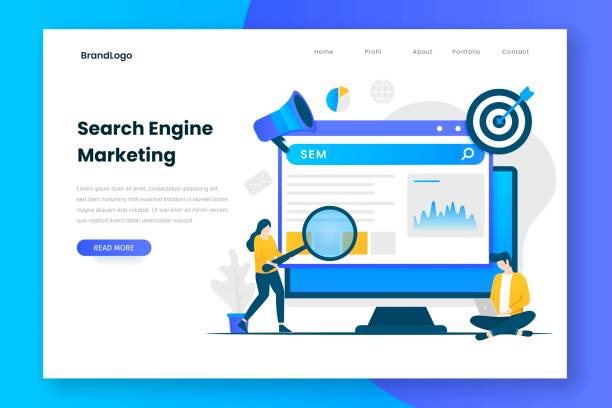Introduction to the Importance of Secure Website Design in Today’s Digital World

#Cybersecurity and #DataProtection have today become one of the most critical concerns for online businesses.
With the ever-growing expansion of online businesses, the need for secure website design is felt more than ever.
An insecure website can not only lead to the loss of sensitive user data but also severely damage your brand’s reputation.
This section provides a comprehensive explanation of why website security is important and its role in maintaining user trust.
Neglecting security issues can turn your site into an easy target for hackers, resulting in information theft, data destruction, and even complete website shutdown.
Secure website design means implementing protocols, tools, and procedures that make your website resilient against potential attacks.
#User_Trust and its preservation are among the most important achievements of a secure website.
Users, when assured that their personal and financial information is safe on your website, will more comfortably use your services and products.
In fact, security is not an option but a vital requirement for any website that intends to succeed in the long term.
Furthermore, adherence to security standards and data protection regulations (such as GDPR) is of high importance for many businesses, and non-compliance can lead to heavy penalties.
This educational approach helps you gain a comprehensive view of various aspects of web security.
This is the first step towards achieving a secure and stable website design that adheres to security principles in all aspects, from infrastructure to content.
In the following sections of this article, we will delve into more specialized details and practical solutions for secure website design.
Does your company’s website perform as it deserves for your brand? In today’s competitive world, your website is your most important online tool. RasaWeb, a specialist in professional corporate website design, helps you to:
✅ Build customer credibility and trust
✅ Convert website visitors into customers
⚡ Get a free consultation!
Familiarity with the Most Common Website Security Threats

#Cyber_attacks come in various forms, and every website administrator must be familiar with the most common ones to plan for secure website design.
This analytical section introduces and examines these threats.
One of the most prevalent attacks is SQL Injection, where an attacker injects malicious SQL code into the database, gaining access to or altering sensitive information.
Another is Cross-Site Scripting (XSS), where malicious JavaScript code is injected into the website and executed in users’ browsers, which can lead to the theft of cookies or session information.
These types of attacks show how even the slightest weakness in secure website design can have significant consequences.
#Malware and #Phishing are also serious threats.
Malware refers to malicious software installed on a user’s system without their knowledge, which can steal information or damage the website.
Phishing attacks deceive users into entering their login credentials by spoofing legitimate website pages.
DDoS (Distributed Denial of Service) attacks also render websites inoperable by sending a massive volume of traffic to the server.
Understanding these threats is the first step towards implementing a secure website design and creating appropriate defensive mechanisms.
Grasping the depth of these attacks helps you take the need for secure website design seriously and implement necessary preventive measures.
This section provides a specialized overview for understanding common attacks and the high importance of security in website development.
The Role of SSL/TLS Certificates and HTTPS Protocol in Secure Website Design

#SSL/TLS_Certificate and the use of #HTTPS are integral components of a secure website design.
This specialized section discusses the importance of these protocols.
SSL (Secure Sockets Layer) and its newer version TLS (Transport Layer Security) are protocols that encrypt communication between the user’s browser and the website server.
This encryption ensures that exchanged information, including login credentials, credit card numbers, and personal data, is protected from unauthorized access.
Websites that use SSL/TLS begin with HTTPS instead of HTTP.
Having an SSL certificate is not only essential for security but also positively impacts website SEO and ensures secure website design.
#Data_Encryption with HTTPS builds user trust.
Browsers mark websites without HTTPS as “insecure,” which can lead to a decrease in website traffic and credibility.
For secure website design, installing a valid SSL certificate and correctly configuring it on the server is essential.
There are different types of SSL certificates, including DV (Domain Validation), OV (Organization Validation), and EV (Extended Validation), each offering varying levels of assurance and trust.
Choosing the appropriate certificate depends on the type of business and the sensitivity of the information you process.
Table 1: Common Web Vulnerabilities and Secure Website Design Solutions
| Vulnerability | Description | Solution for Secure Website Design |
|---|---|---|
| SQL Injection | Injecting malicious SQL codes into the database | Using Prepared Statements and parameterized queries |
| Cross-Site Scripting (XSS) | Injecting malicious scripts into web pages | Input/Output Sanitization |
| Broken Authentication | Weakness in authentication mechanisms (weak password, improper session management) | Multi-Factor Authentication (MFA), strong password encryption, secure session management |
| Insecure Direct Object References | Direct access to internal resources without proper access control | Implementing strong access control on all direct object references |
Secure Coding Practices for Web Developers

#Secure_Programming is a key element in secure website design.
This educational and specialized section helps web developers write code that is resistant to attacks from the outset.
One of the fundamental principles is “input validation.”
Never trust data coming from the user.
All inputs, whether from forms, URLs, or APIs, must be carefully reviewed and sanitized to prevent the injection of malicious code.
This includes checking data type, length, format, and content.
Also, using parameterized queries for database interaction, instead of direct string concatenation, prevents SQL Injection and strengthens the foundation of a secure website design.
#Software_Updates and updating libraries used are another critical aspect.
Developers must always ensure they are using the latest versions of frameworks, libraries, and tools, as older versions may have known security vulnerabilities.
Error and Log Management must also be done securely; sensitive information should never be displayed in error messages, and logs should be regularly and securely stored to allow for tracking in case of an issue.
Proper encryption of sensitive information, using strong hashing functions to store passwords, and applying the Principle of Least Privilege in access control, all significantly contribute to secure website design.
Awareness of OWASP Top 10 and using its solutions is essential for any developer aiming for secure website design.
Are you lagging behind big online stores in the competition?
RasaWeb, with professional e-commerce website design, brings your business online and increases your market share!
✅ Increase brand credibility and customer trust
✅ Easy shopping experience leading to more sales
⚡ Get a free website design consultation now!
Choosing a Secure Web Host for Your Website

#Secure_Hosting is one of the main pillars of secure website design that is often overlooked.
This guidance helps you make the best decision in choosing your web hosting provider.
A reputable and secure web host should have features such as powerful firewalls (WAF), Intrusion Detection/Prevention Systems (IDS/IPS), and DDoS attack protection.
Also, servers must be regularly updated and have the latest security patches.
Checking the hosting company’s security history and other users’ reviews can give you a good insight.
Strong and accessible technical support is also crucial, as you need a quick response in case of any security issue to prevent your secure website design from being compromised.
#Regular_Backup and automatic data backups are another important point in choosing a secure host.
Ensure that your hosting provider regularly and frequently backs up your website and stores these backups in secure, off-site locations.
Also, the ability to easily and quickly restore data from backups is very important.
Environment Isolation of websites from each other on a shared server is another security feature that you should pay attention to; this ensures that an attack on one website on the server does not affect other websites and your secure website design is maintained.
Finally, adhering to the Principle of Least Privilege for hosting staff and continuous monitoring of server activities are other aspects that a secure web host must comply with.
This correct choice plays a large role in the overall stability and security of your secure website design.
Database Security and Protection of Sensitive Information

#Database_Security is the heart of any secure website design, as the most sensitive information, including users’ personal data and transaction details, is stored there.
This specialized section discusses key strategies for database protection.
The first step is the encryption of sensitive data both in transit and at rest.
Credit card information, passwords, and other personal data should never be stored in plain text.
For passwords, strong hashing functions (such as bcrypt or Argon2) should be used along with salt so that even if the database is leaked, user passwords cannot be reconstructed.
#Access_Management to the database is of paramount importance.
Never use the “root” user account to connect to the database via the website.
Instead, define users with the minimum necessary access rights for the required operations.
For example, if your website only needs to read and write specific information, grant only that level of access.
Database Firewall and Database Activity Monitoring (DAM) systems can help identify and prevent attacks.
Also, all unnecessary database ports should be closed, and access should only be allowed from authorized IP addresses.
Regular and tested backups of the database ensure that information can be recovered in the event of a disaster.
These approaches ensure that your secure website design penetrates deeper into the data beyond the superficial layer of the website.
Without a secure database, all efforts for secure website design will be fruitless.
Securing Content Management Systems (CMS)

#CMS_Security is one of the major challenges in secure website design, as Content Management Systems like WordPress, Joomla, and Drupal are attractive targets for hackers due to their high popularity.
This guidance and specialized section discusses how to secure your CMS.
The first and most important step is regular updates of the CMS core, themes, and plugins.
The developers of these systems constantly release security patches to fix discovered vulnerabilities.
Failure to update in a timely manner can make your site vulnerable to known attacks.
#Security_Plugins for CMSs are powerful tools that can create additional layers of protection.
These plugins can provide features such as a website firewall (WAF), malware scanning, two-factor authentication, and protection against Brute Force attacks.
Choosing reputable and well-established plugins is of great importance.
Also, using strong and complex passwords for all CMS user accounts, especially administrative accounts, is mandatory.
Removing unnecessary plugins and themes and changing the default admin login URL are also effective security measures.
Proper user access management, meaning that each user only has access to the sections they need to perform their tasks, is another important point in secure website design based on CMS.
These measures help you protect your information and users with a secure website design.
Table 2: CMS Security Checklist for Secure Website Design
| Security Action | Description |
|---|---|
| Continuous Updates | Keep CMS core, themes, and plugins updated to the latest version. |
| Use of Strong Passwords | Create complex and unique passwords for all users, especially administrators. |
| Activating Two-Factor Authentication (2FA) | For an additional layer of protection when logging into the admin panel. |
| Removing Unnecessary Plugins and Themes | The fewer, the fewer potential vulnerabilities. |
| Changing Default Login URL | Preventing Brute Force attacks on the default login page. |
| Securing wp-config.php file (for WordPress) | Restricting access to this critical file. |
| Installing a Reputable Security Plugin | For firewall, malware scanning, and comprehensive protection. |
The Importance of Security Audits and Penetration Testing

#Security_Audit and #Penetration_Testing are essential pillars in secure website design.
This analytical and specialized section explains these concepts and their necessity.
A security audit is the process of comprehensively reviewing website systems, code, configurations, and protocols to identify potential vulnerabilities and weaknesses.
This is done periodically and regularly to ensure that the website is always resilient to new threats.
Security teams or external specialists can perform these audits.
The primary goal is to find problems before hackers discover and exploit them.
#Cyber_Vulnerabilities are often hidden in various layers of the website, from server infrastructure to programming code and even CMS settings.
Penetration testing, or Pentesting, goes a step further; in this process, security specialists attempt to penetrate your system using techniques and tools that hackers also use.
This controlled attack simulation helps identify operational weaknesses that might be overlooked in traditional audits.
The final penetration test report includes details of discovered vulnerabilities, how they can be exploited, and practical solutions to fix each one.
Regular penetration testing is an integral part of a secure website design strategy and ensures that your website remains under continuous protection even after launch.
This guidance emphasizes the importance of these tests for guaranteeing secure website design.
Does your company’s website create a professional and lasting first impression on potential customers? RasaWeb, with professional corporate website design, not only represents your brand’s credibility but also paves the way for your business growth.
✅ Create a powerful and reliable brand image
✅ Attract target customers and increase sales
⚡ Get a free consultation
Incident Response Planning and Backup Strategies

#Incident_Response and #Disaster_Recovery are critical aspects of secure website design that are often overlooked.
Even with the best preventive measures, no website is 100% immune to attacks.
This explanatory and guidance section discusses the importance of having an operational plan for dealing with security incidents.
An incident response plan should include identification, containment, eradication, recovery, and post-incident analysis steps.
The responsible team must clearly understand their duties at each stage and have the necessary tools to perform them.
This planning helps minimize damage and website downtime.
#Regular_Backup of all website data, including files, database, and configurations, is the foundation of a disaster recovery strategy.
These backups should be performed automatically and at regular intervals (daily, weekly) and stored in secure, off-site locations.
More important than merely backing up is regular testing of the recovery process.
You must ensure that you can fully and flawlessly restore your website using these backups.
Having multiple versions of backups (e.g., daily, weekly, and monthly backups) is also recommended so that if one version is compromised, previous healthy versions are available.
These measures ensure that even in the worst-case scenario, your secure website design is supported by a robust recovery plan, and your business can quickly return to normal, thereby transforming secure website design from a preventive concept into a comprehensive strategy.
The Future of Web Security and New Trends in Secure Website Design

#Future_Security of the web is constantly evolving, and with the emergence of new technologies, new challenges and solutions for secure website design also arise.
This news and entertaining section discusses some of the future trends in cybersecurity.
With the advancement of Artificial Intelligence (AI) and Machine Learning (ML), we are witnessing the emergence of smarter security systems that can identify attack patterns and respond to them automatically.
These technologies enable websites to predict and neutralize unknown threats, thereby elevating secure website design to a new level.
#Blockchain and its applications in web security have also gained attention.
Blockchain technology, due to its decentralized and immutable nature, can be used in data security, user authentication, and even DNS.
This technology can help create websites with a much higher level of security.
The issue of Data_Privacy has also gained more importance with new regulations such as CCPA and GDPR.
Businesses must adopt a “Privacy by Design” approach in their secure website design.
Do these new trends mean the end of cyberattacks? The thought-provoking content is that despite technological advancements, hackers also develop their methods, and secure website design will always require vigilance and continuous updates.
Therefore, consistency and adaptation to the latest standards are the keys to success in maintaining website security in the future.
Secure website design is not a static process, but a dynamic and continuous path.
Frequently Asked Questions
| Row | Question | Answer |
|---|---|---|
| 1 | What is secure website design? | The process of designing and developing websites that are resistant to cyberattacks and protect user data and privacy. |
| 2 | Why is website security important? | To prevent data breaches, financial losses, damage to company reputation, and maintain user trust. |
| 3 | What are some common website security threats? | SQL Injection, XSS (Cross-Site Scripting), CSRF (Cross-Site Request Forgery), weak authentication, and outdated software. |
| 4 | What is SSL/TLS and what is its role? | Protocols for encrypting data between the user’s browser and the website server, ensuring secure and private communication. |
| 5 | How can SQL Injection attacks be prevented? | By using Prepared Statements/Parameterized Queries, input validation, and ORMs (Object-Relational Mappers). |
| 6 | What is the role of a Web Application Firewall (WAF) in security? | A WAF monitors and filters HTTP traffic between a web application and the Internet to prevent malicious attacks. |
| 7 | Why is regular software and library updating necessary? | Updates include patches for known security vulnerabilities that attackers can exploit. |
| 8 | How can XSS attacks be prevented? | By sanitizing and escaping all user inputs before displaying them on the web page and using a Content Security Policy (CSP). |
| 9 | What does the Principle of Least Privilege mean? | It means that users and systems are given only the minimum necessary permissions to perform their tasks, preventing unnecessary access to resources. |
| 10 | What is the importance of proper user session management? | To prevent session hijacking and unauthorized access to user accounts through secure and expiring session tokens. |
And other services of RasaWeb advertising agency in the field of advertising
Smart Advertising Campaign: A dedicated service for growth based on customer behavior analysis and key page optimization.
Smart Custom Software: An effective tool for online growth using real data.
Smart Link Building: A dedicated service for improving SEO ranking based on Google Ads management.
Smart Sales Automation: Professional optimization for online growth by customizing user experience.
Smart Data Analysis: A fast and efficient solution for increasing click-through rates with a focus on custom programming.
And over a hundred other services in the field of internet advertising, advertising consultation, and organizational solutions
Internet Advertising | Advertising Strategy | Advertorials
Sources
Essential tips for increasing business website security
Principles of secure site design and protection against cyberattacks
Most common website security threats and ways to combat them
Choosing secure hosting for your business website
? For the growth and prosperity of your business in the digital world, RasaWeb is with you every step of the way. With our comprehensive services, including responsive website design, professional SEO, and content marketing, we pave your path to success.
📍 Tehran, Mirdamad Street, next to Bank Markazi, Kazeroun Jonoubi Alley, Ramin Alley, No. 6


